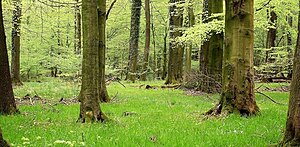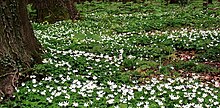Kurler Busch nature reserve
|
NSG Kurler Busch
|
||
|
Forest meadow |
||
| location | Dortmund , North Rhine-Westphalia , Germany | |
| surface | 197.34 ha | |
| Identifier | DO-008 | |
| WDPA ID | 165096 | |
| Geographical location | 51 ° 34 ' N , 7 ° 35' E | |
|
|
||
| Setup date | 1986 | |
The Kurler Busch nature reserve is located in the north-east of Dortmund in the Scharnhorst district between the districts of Kurl and Husen in the south and Lanstrop in the north, in North Rhine-Westphalia , Germany. It covers an area of 197.3466 hectares , making it the largest nature reserve in Dortmund. The Kurler Busch nature reserve was designated on June 19, 1986 by means of a temporary seizure by the Arnsberg district government. On November 30, 1990, it was set in the Dortmund-North landscape plan and this was confirmed on September 2, 2005 in the first change to the landscape plan.
description
As the most valuable, structurally rich mixed oak forest, which consists almost entirely of deciduous trees, its importance arises from its relative undisturbed location on the outskirts, surrounded by agricultural areas, the low forest use and the relatively humid location.
Within the forest there are two small ponds, several small bodies of water and a larger body of water created by subsidence . These provide habitat for a large amphibians occur and a gray heron colony. Several mostly straight streams run through the Kurler Busch. The headwaters of the Rahmsloh brook have a wide reed border with dead trees in the center of the wet meadows . This area is bordered by a wet alder forest . In the central Kurler bush there are local locations of hornbeam and Book , partly in a millet pass -Buchenwald.
In the north of the Kurler Busch, there is the local recreation area around the Rahmsloher Bach.
The Kurler Busch has cross-city significance: it is used intensively not only by Dortmunders but also by the people of Kamen to the east , because Kamen itself is very poor in forests.
Specially protected species
Several species that are on the red list of endangered species live in the Kurler Busch habitat :
- Gray heron (EU code A028)
- Cormorant (EU code A017)
- Little Grebe (EU code A004)
Protection goals
The most important protection goal is the preservation of this structurally rich, natural deciduous forest with its wet meadows and small bodies of water as a retreat and stepping stone biotope in the Hellweg region.
Web links
- Nature reserve “Kurler Busch” in the specialist information system of the State Office for Nature, Environment and Consumer Protection in North Rhine-Westphalia
- BUND Dortmund: Kurler Busch - The largest contiguous nature reserve in Dortmund






